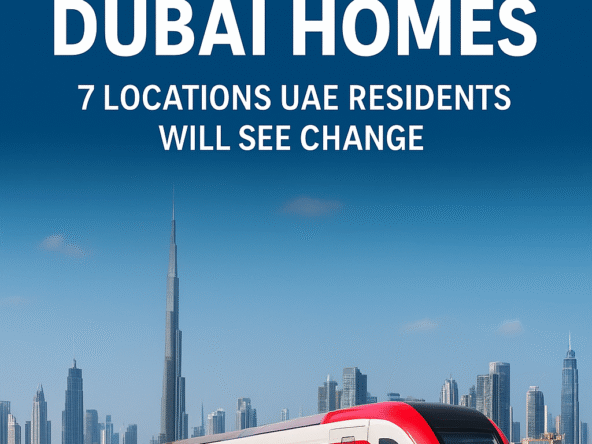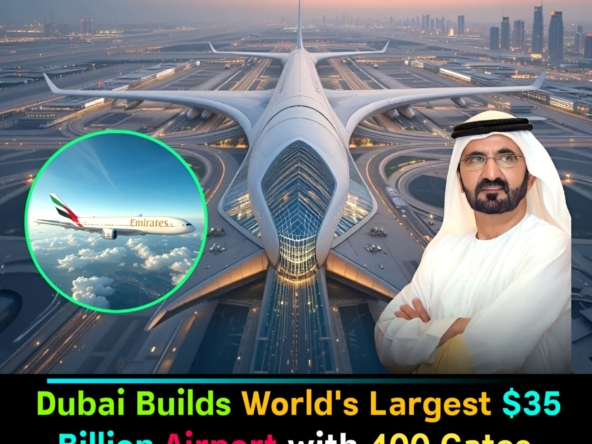Dubai has long been known as a city of ambition, luxury, and futuristic development. One of its most iconic infrastructure projects—Dubai International Airport (DXB)—has been the backbone of its transformation into a global aviation hub. However, in recent years, the spotlight has shifted to a new colossal development: Al Maktoum International Airport (DWC), also known as Dubai World Central. With plans to make DWC the world’s largest airport, Dubai is making a bold and strategic shift. But why is the city moving operations from a successful and busy airport to a brand-new one?
Let’s explore the motivations, benefits, and broader implications behind this transition.
A Quick Overview: Al Maktoum International Airport
Located in Jebel Ali, roughly 37 kilometers southwest of downtown Dubai, Al Maktoum International Airport was opened in 2010. Initially, it catered only to cargo operations, with limited passenger services. But this was just the beginning. The airport is part of the massive Dubai South development, a 145-square-kilometer urban project aimed at creating a smart, sustainable city with residential, commercial, logistics, and aviation zones.
The long-term goal? To make DWC the largest airport in the world, capable of handling over 260 million passengers per year and 12 million tons of cargo annually.
Why Move Away from Dubai International Airport (DXB)?
Dubai International Airport is currently the world’s busiest airport by international passenger traffic, handling over 85 million passengers in peak years. It’s a symbol of Dubai’s rapid growth and economic dynamism. So why replace it?
Here are the key reasons:
1. Space Constraints and Expansion Limits
DXB is located in the heart of the city, surrounded by densely populated neighborhoods and commercial zones. This urban location makes further expansion extremely difficult. The airport is already operating at close to its maximum capacity, with little room for significant infrastructure upgrades or runway extensions.
By contrast, DWC is located in a vast, underdeveloped area with ample space for scalable expansion. This means more runways, terminals, and supporting infrastructure can be added as needed, without disrupting surrounding communities.
2. Future-Proofing Aviation Needs
As aviation technology evolves and passenger numbers continue to rise, airports need to adapt. Al Maktoum International is being built with next-generation aviation in mind, including features that support:
- Advanced air traffic control systems
- Larger aircraft like the Airbus A380 and future hybrid or electric jets
- Seamless digital integration for security, immigration, and passenger services
In short, DWC offers Dubai the chance to design an airport for the next 50 years, not retrofit one from the past.
3. Cargo and Logistics Integration
DWC is strategically integrated into Dubai South, which is planned as a global logistics and business hub. The proximity to Jebel Ali Port—the largest port in the Middle East—creates a unique multimodal transport network combining sea, air, and land freight services.
This air-sea logistics corridor allows for faster turnaround times for cargo, reduced costs, and increased competitiveness, reinforcing Dubai’s role as a logistics gateway between East and West.
4. Relieving Urban Congestion
DXB contributes significantly to congestion in central Dubai—not just air traffic, but also on roads, public transport, and surrounding infrastructure. Moving operations to DWC will distribute traffic more evenly, reduce stress on city infrastructure, and help in urban planning and environmental management.
5. Tourism and Economic Diversification
Dubai’s long-term economic vision includes becoming a top global destination for tourism, business, and investment. A new, larger, and more advanced airport enhances the city’s ability to attract major events (such as World Expos), international conventions, and an ever-growing number of tourists. This aligns perfectly with the UAE’s broader Vision 2030 strategy.
The Scale of the New Airport: A Mega Project in the Making
Al Maktoum International is set to be five times larger than DXB upon completion. Some highlights of the mega-project include:
- Five parallel runways
- Five passenger terminals
- Capacity for 260+ million passengers annually
- 100,000+ parking spaces
- Integrated high-speed rail and metro connections
- Sustainable, smart infrastructure powered by renewable energy
With a cost estimated at $33 billion, this is not just an airport—it’s a city within a city, built to transform global aviation and commerce.
Timeline and Transition
The shift from DXB to DWC won’t happen overnight. It’s a phased process that could span over a decade. The full expansion of Al Maktoum International is expected to be completed by 2030, although passenger services and selected airline operations have already begun.
Several key developments are underway:
- Emirates Airlines, Dubai’s flagship carrier, is preparing for a partial relocation by the end of the decade.
- Cargo operations are increasingly being shifted to DWC.
- Infrastructure for transit, accommodation, and commercial zones around the airport is rapidly being developed.
Challenges and Considerations
Despite the enthusiasm and long-term benefits, there are challenges to overcome:
- Cost and funding: The $33 billion investment is massive and requires consistent financial backing.
- Coordination: Moving airlines, employees, and logistics operations needs complex coordination with minimal disruption.
- Public adaptation: Travelers and businesses will need time to adjust to the new location, which is farther from the city center.
However, Dubai has a strong track record of delivering major projects on time and with precision, such as the Burj Khalifa, Palm Jumeirah, and Dubai Metro. With strong government backing and a clear vision, these challenges are likely to be well managed.
Final Thoughts: A Visionary Leap
The transition from Dubai International Airport to Al Maktoum International is not just about handling more passengers or building bigger terminals. It’s about redefining what an airport can be—a central piece in a smart, connected, and diversified economy.
Dubai has always thrived on visionary thinking and the ability to execute complex infrastructure projects. By shifting to DWC, the city is not only preparing for its own growth but also reshaping the future of global air travel.
Whether you’re a frequent flyer, a logistics expert, or an urban development enthusiast, the evolution of Al Maktoum International Airport is a story worth watching—a bold step into a smarter, faster, and more connected future. Why Dubai Is Shifting to Al Maktoum International Airport: A Bold Move for the Future of Aviation
https://www.tiktok.com/@corenestrealestatellc
https://www.youtube.com/@CoreNestRealEstateLLC
https://www.facebook.com/corenestrealestatellc
https://www.instagram.com/corenestrealestatellc
https://www.pinterest.com/corenestrealestatellc/
https://www.linkedin.com/in/corenestrealestatellc/
Every New latest Post brings by Core Nest Real Estate LLC
https://corenestrealestate.com/





